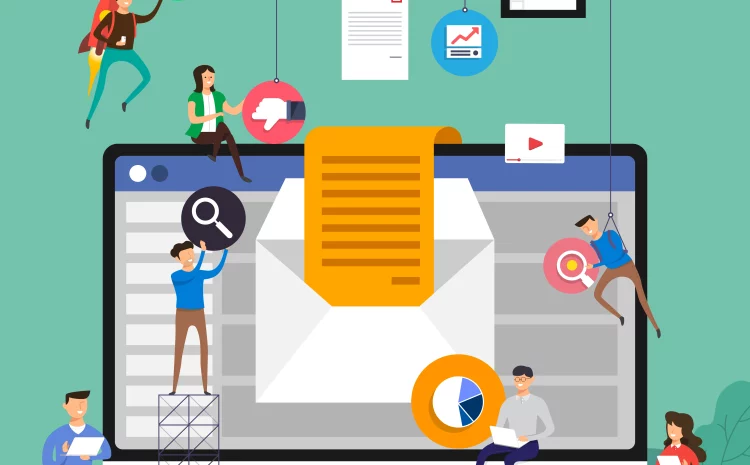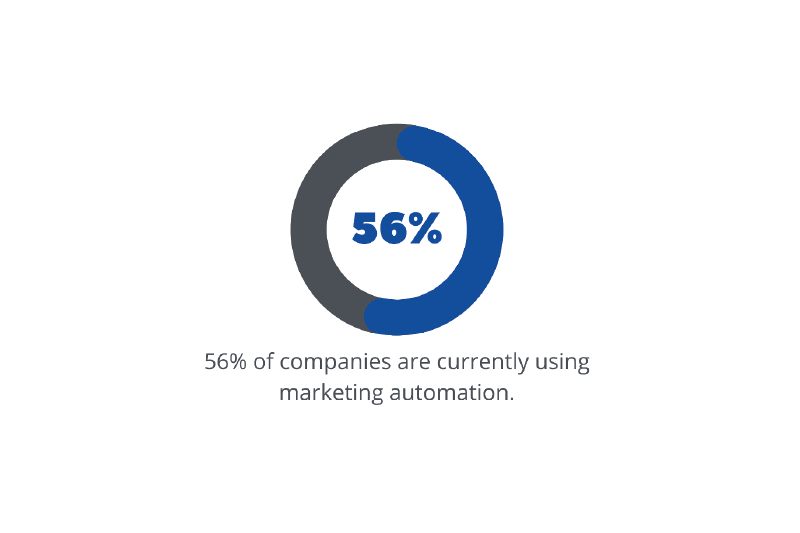
Automation is the new norm in business today. It undeniably saves time, boosts productivity, and saves a poor human operative from physically having to handle tedious, robotic tasks.
Yet automation can provide far more than mere improved efficiency.
Nowhere is the true value of business automation seen more clearly than in marketing automation.
So let’s explore the revenue-boosting, time-saving, lead nurturing world of marketing automation.
What is Marketing Automation?
Marketing automation is when technology is used to handle simple (often repetitive) marketing and lead nurturing tasks independently of human input. This is often controlled through software that allows human users to create simple, usually visual, workflows that operate on “if this then that” logic.
For example, a marketer can set up an automation flow which automatically sends customers a free coupon code for carrying out a certain action, such as signing up to their newsletter or completing an online purchase.
It takes the manual work out of small lead generation actions that can make all the difference to a customer.

What’s the Point of Marketing Automation?
On average 56% of companies are currently using marketing automation. 40% of B2B companies are planning to adopt the technology. (Source: Emailmonday, 2022)
Think of all of the work that goes into getting a single customer to convert online. A single buyer’s journey might involve tracking cookies, social media ads, email marketing, online voucher codes, web searches, click throughs, an initial sales enquiry, sales follow-ups, conversion, after sales, and all sorts of micro-actions in between.
There are a lot of moving, technical parts that need to follow each user around the web and come together to create a successful conversion. If the marketing team had to manually handle small, scrappy tasks like setting up a CRM entry or sending out a routine email campaign to a set subscriber list every time certain criteria were met, their job would be very tedious indeed.
All in all, by automating these small-yet-crucial “connective” tasks, your marketing and sales teams can focus on the things that only a human operative can do – formulating inventive strategies, actively liaising with prospects, and continuously improving the whole buying process.
We’ll explore some more in-depth benefits of marketing automation shortly.
What Marketing Activities Can be Automated?
- Email Marketing: Email marketing automation is one of the more common types of marketing automation you’ll see out in the wild. Automated email campaigns send out one email or a flow of predetermined emails (a “drip campaign”) when a subscriber fulfils certain criteria – for example when they join a subscription list, click a specific link, or make an online purchase.
- Integrated CRM Automation: There’s not much point in keeping two separate systems which independently manage your email lead generation and your CRM functions. When lead gen is integrated with CRM functionality, you can set workflow triggers and actions for things across the entire sales and marketing process; for example, drip campaigns based on lead score; a prospect’s place in the buyer’s journey; sales tasks triggered by marketing interactions, etc.
- SMS Marketing Automation: Text messages receive a , so if it makes sense to your business and marketing strategy, they can be an excellent marketing channel (automated or otherwise!). SMS automation can be as simple as automating a “how did we do?” message after a customer visit, appointment reminders, event attendee reminders; all the way to multi-stage automated SMS drip campaigns.
- Pay-Per-Click Ad Automation: These are tools that let you automate certain elements of search and social , including bidding, targeting, and even keyword research. Some PPC automation tools even feature AI writers that provide compelling copywriting suggestions!
- Omni-Channel Marketing Automation: Omni-channel marketing is where advertisers use consistent messaging and collateral across all marketing channels, staying on-brand wherever the prospect sees them. This consistent, brand-wide strategy can be further amplified with automated marketing practices that tie channels together, so the prospect only ever sees a consistent, unified message from the brand.
- Social Media Automation: Social media output can also be automated, with post “recycling” tools, the ability to schedule posts ahead of time, tools which post at the best time, and so on. Social media automation doesn’t generally use workflows in the same way as direct marketing methods do, but scheduling and recycling posts certainly cuts down on time spent posting manually.

What is “No-Code” Automation?
No-code automation tools let users configure their own automation flows through a simple graphical interface rather than having to program it manually. No-code tools especially benefit teams with varied technical knowledge as they’re designed to be accessible to most users.
It’s also worth knowing about a similar concept, low-code automation, which allows people to carry out some of the more common automation setup through a visual interface, but lets those with programming skill fine tune that functionality using their own code.
What Can You Do with Marketing Automation?
Welcome & Nurture New Leads Automatically
Got a new subscriber or customer? Great! Hit it off with them straight away by sending them an automated, spaced out flow of emails to keep your brand top of mind. Called a “welcome sequence”, it’s somewhat common practice within email marketing, but can also be achieved through SMS texts and even PPC to an extent.
Alternatively, if your subscribers have to wait a while for you to write to them manually, they may have forgotten why they were interested in you in the first place!
Up-Sell or Cross-Sell to Existing Customers
Automated campaigns can also be used after conversion to cross- or up-sell a related product/service. Automation can be set up to add customers to an up-selling drip campaign after purchasing a certain product that focuses on the next logical purchase.
That could be an upgrade to their existing service or a new product that would deepen their relationship with their existing purchase. Automated campaigns are also useful to send as a reminder to renew or restock something cyclical, or can be used to advertise a seasonal product to those who have shown interest in the past.
Discover How Really Simple Systems Can Help
Encourage Re-engagement from Older Leads
Drip campaigns – whatever the format – aren’t just for new customers. If you identify a segment of older, opted-in leads who have gone a bit cold, you can use the engagement data you have about them to create an automated drip campaign that speaks to their doubts and gets them headed back towards conversion.
Orchestrate Complex Cross-Channel Campaigns
Omni-channel automation tools can help you plan out and execute complex logical flows across different platforms, pulling the strings across all channels with the greatest of ease. The only limit to the complexity is your imagination!
Being omnipresent is a great strategy in marketing. If your ideal customer can’t move online without encountering an ad or a piece of content from you, that’s great for brand awareness – as long as it doesn’t get annoying, of course! Applying logical, strategic flows to your entire digital presence allows you to put a strategic and professional front forward online, rather than appearing haphazard and scattergun.
Collect Cross-Channel Analytics
As a marketer, what do you do when none of your analytical functions talk to each other? Google Analytics stays with Google, Twitter Analytics stays on Twitter, sales data stays in your CRM, and email marketing analytics stays on your email marketing platform. Do you put up with the blinkered approach of viewing each dataset in a vacuum, or do you take the time to tie that data together every month?
Omni-channel marketing tools pull together a complete bird’s-eye-view of your marketing, so they will generally tie the relevant channels together to provide meaningful cross-channel insights too. Even without omni-channel tools, solutions like Zapier and Google Data Studio can do some of the analytical heavy lifting.
What are the Benefits of Marketing Automation?
Improve Conversion Rates
When all of your sales and marketing activities work together like a well-oiled machine, your conversion rates naturally benefit. In fact…
Understanding your audience is paramount. So when you have all of your marketing data flowing through a single solution, you can easily spot engagement trends, track prospect/buyer habits, and change tack when things aren’t working.

56% of marketers using marketing automation platforms have seen an increase in conversion rates. (Source: Demand Spring, 2021)
Less Busywork, More Strategy
Any kind of well-placed automation can massively boost efficiency and productivity for whoever is using it. Marketing automation takes small, procedural tasks off your marketers’ plates so they can put all of their attention and energy into coming up with imaginative campaigns, uncovering strategic insights, and investigating analytical metrics.
In short, it lets robots do the programmable, robotic stuff so your humans can do the creative, innovative stuff.
Generate and Nurture Leads on Autopilot
When you get a hot new lead, there’s little point in letting them go cold. Automation lets you incorporate interested leads into your marketing outreach straight away while their buying intention is at its highest – striking while the proverbial iron is hottest.
Marketing automation can improve relations with existing leads too. They can be included in targeted reengagement campaigns that address why they may have gone cold to begin with. If you have any totally cold, unengaged leads (for example those who never open your marketing emails) and send a tempting, low-commitment offer to get them back on the hook.
Email drip campaigns can even be offered as in their own right, presented as a short, free course or a timed step by step guide.
Improves Sales & Marketing Cohesion
Your sales and marketing departments are both directly responsible for increasing an organisation’s revenue. So why do so many organisations keep sales and marketing data siloed and mutually inaccessible?
Integrating your CRM and email marketing tools is a hugely beneficial move – and something we’ve discussed in the past. But think of the powerful offers your sales team could formulate if they had fully automated, real-time visibility into the complete digital pre-sales process?
Possible blog topic as you don’t have anything that directly appeals to “lead magnet” keyword?
Knowing prospects’ full interaction history can give your sales team an incredible amount of insight before they pick up the phone. And vice versa, think of the power your marketing team could wield if they’re aware of the most common sales objections and can nip them in the bud early on in the sales funnel?
Precise, Joined-Up Reporting
Pulling together performance reports with data from different platforms can be a tedious, manual task. However, marketing automation tools can put this once monotonous task a simple click away.
With all data drawn together, you can establish a clear bird’s-eye view of your whole pre-sales processes. This can help you find places where work is being duplicated or over-complicated and can help you uncover new opportunities for messaging and retargeting.
Remember – your customer doesn’t see the hand-off between sales and marketing. They just see your brand as a combined whole. Automated, coordinated reporting lets you approach your pre-sales tasks as a combined whole too.
Improves Lead Scoring Efforts
When all sales and marketing data is pulled together to automate tasks, this can lead to a more accurate, company-wide method of scoring and prioritising the leads you have on your books.
Knowing how eagerly a sales lead interacts with marketing collateral could hint to salespeople that the person is ready to buy (called “behavioural lead scoring”). Alternatively, if a previously hot lead falls off the map engagement-wise, this could hint that they need a quick call to get them back into the fold.
Improved lead scoring can also feed back into marketing automation too. When you have a better idea of levels of prospect interest, you can better formulate automated campaigns that speak to their individual needs – or create automation-driven PPC campaigns to draw in other buyers like them.
Provide a Better, More Personalised Customer Experience
97% of marketers witnessed a rise in business outcomes as a result of personalisation. (Source: Salesforce, 2020)
Statistics about marketing personalisation are pretty unanimous: personalisation is the way to go.
Yet marketing personalisation depends on robust automation tools to function. Everything from simple mail merge personalisation to using a complex, automated logic flow to decide what message to send to each lead next – it all boils down to automation.

